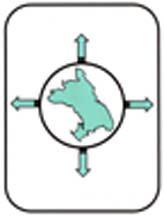WE Riders Analysis Report, Dr. Jason MacCannell
Excerpts from the Report's Introduction
"What have the WE Riders done? Though it sounds like a humorous accusation, the question is a serious one. Officially, the answer is “art”: arts funding supports it; art venues host it. While it is not a set of paintings on the wall, the documentation here fits the conventional definition of art more closely than some “conceptual” art. Here is a display, some distinctive patterns of visual design, and even a great deal of drawing, albeit not by the artists. If the artists themselves had produced the bulk of the works on display—nearly two hundred small sheets that include both drawings and writings—no one could question the “artistic” nature of the project. But the work is instead a collaboration between the artists and members of the public selected more or less haphazardly.
In this sense the project is more like social science than “art.” Instead of depicting their ostensible subjects, the sometimes elusive realms of West and East Oakland, the WE Riders mounted a survey, collecting eighty-one maps as well as a large volume of commentary. Every stage of the project has been lavishly documented, on paper, on a weblog, in digital photography, on video, and even in GPS point data from the rides. As a social scientist who met them quite by accident, I admit I was initially fooled by what Donna Haraway might call their scientific “drag.” It took some investigation to discover that their approach was entirely artistic.
… But my purpose here is not to judge the quality of the art, nor analyze the critique or celebration of science that some might see embedded in it. Rather, I intend to push the “science” of the WE Riders project as far as possible, treating their data as data, searching it for anything suggestive of a pattern or correspondences among its elements. In doing so I am quite conscious of blurring the boundary between art and science even further. By not asking a research question—“Where is East/West Oakland?” being too nebulous to count—the WE Riders have ensured that no answer will be found. There is no effect whose cause is sought, nor any stakeholders waiting to applaud or defy a politically important result. In the end the respondents became the scientists, the ones proferring hypotheses and presenting evidence.
… The portrait of Oakland and specifically these neighborhoods that emerges in the survey—a city divided by freeways, a city divided by a lake, a place with multitudinous pasts carried in the hearts of its residents, a place where the future seems to rumble like an angry faultline under the surface, a set of stops on the BART lines, a place that business and government desperately want changed, a place with Victorian houses and taco stands, a place where west is north and east is south—is a portrait as variable as the city itself that mere statistics could not achieve."



0 Comments:
Post a Comment
<< Home